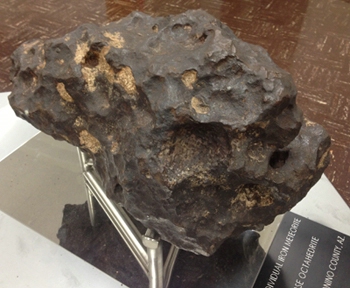May 20 2013
Nearly 50,000 years ago, an asteroid fragment slammed into Earth approximately 40 miles east of what is now Flagstaff, Ariz.
 Canyon Diablo, a 357-pound chunk of a meteor that slammed into Earth 50,000 years ago, sits center stage at UCLA's new Meteorite Museum.
Canyon Diablo, a 357-pound chunk of a meteor that slammed into Earth 50,000 years ago, sits center stage at UCLA's new Meteorite Museum.
Upon impact, the celestial projectile shattered into thousands of pieces and created a mile-wide hole now known as Meteor Crater. A 357-pound chunk of that asteroid now sits center stage at UCLA’s new Meteorite Museum, tucked away in the Geology Building. The Canyon Diablo meteorite, once owned by philanthropist William Andrews Clark, Jr., was donated to UCLA upon his death in 1934.
That meteorite became one of the first specimens in a collection that has grown to some 1,500 meteorites under the stewardship of professor John Wasson and researcher Alan Rubin, members of the department of Earth and space sciences and the Institute of Geophysics and Planetary Physics. The collection is one of the most extensive in the world, but only recently have these unique bits of our solar system’s history been on display for visitors to admire.
"For many years, we’ve collected beautiful exhibit specimens, but kept them locked in an inaccessible cabinet," Rubin said. "It’s nice to put them on display for other people to see."
Those expecting the museum to be filled with rows of indistinguishable black rocks may be surprised to learn that there are many types of meteorites — metallic, stony and everything in between. More than one exhibit emphasizes chondrites, a type of meteorite that is the subject of "endless fascination," according to Rubin. "Chondrites are composed of thousands or millions of tiny spherules, called chondrules," he explained.
Chondrites are still very much a mystery, said Wasson. "It appears that chondrules formed from clumps of dust in the solar nebula — the gas and dust cloud that was here before the planets and asteroids formed — and were zapped in a way that is still unknown."
In addition to exhibits of extraterrestrial specimens is a showcase of melted tektites formed from debris from Earth that was ejected during extraterrestrial impacts, as well as Libyan desert glass that formed as a result of meteor impacts.
Another exhibit offers tips on how to correctly identify meteorites. Rubin, a world expert in meteorite identification, gets phone calls nearly every day from meteorite-hunting hopefuls and regularly receives specimens people believe are meteorites. While real specimens occasionally come across his desk, the vast majority of these objects come from Earth. An exhibit humorously dubbed "Meteorwrongs" presents a selection of these, including ordinary rocks, petrified wood, pottery shards and twigs.
Wasson and Rubin hope that the museum, which welcomes visits from school groups, will help educate the next generation of meteorite researchers.
"The museum will be a wonderful teaching resource," Wasson said. "Our goal is to make it the world’s best scientifically oriented meteorite museum."